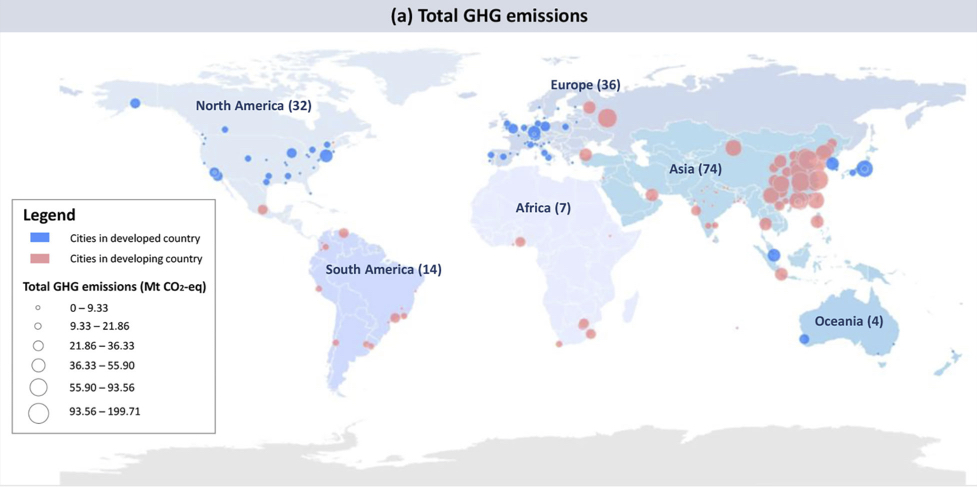- Cities are conspicuous culprits for climate change: they occupy only 2% of the planet’s surface yet account for 70% of annual carbon dioxide emissions.
- A new analysis of 167 cities in 53 countries found that Chinese cities like Handan, Shanghai and Beijing are some of the biggest emitters of greenhouse gases, with per capita emissions comparable to those of developed countries.
- Historically, the U.S. is responsible for a quarter of the world’s greenhouse gas output and the EU’s share is the second-highest at 22%, but in recent decades developing nations like China have overtaken them in annual emissions.
- The 25 most polluting cities, located in both developed and developing nations, are responsible for half of all urban greenhouse emissions, the study authors estimated, arguing that if governments in these urban centers step up their climate ambition it would make an outsized dent in tackling climate change.
The heat wave that swept parts of the U.S. and Canada this June provoked disbelief globally, with temperatures breaching 50° Celsius (122° Fahrenheit). Some see it as a preview of extreme weather to come.
The Earth could heat up by more than 3°C (5.4°F) at the close of this century, and cities are conspicuous culprits for this warming. They occupy only 2% of the planet’s surface yet account for 70% of annual carbon dioxide emissions.

A new analysis of 167 cities in 53 countries found that China’s bustling metropolises are some of the biggest emitters of greenhouse gases. Handan, Shanghai, Suzhou, Dalian and Beijing were the top sources of these warming gases, reporting emissions about three times that of New York City.
The 25 most polluting cities, located in both developed and developing nations, are responsible for half of all urban greenhouse emissions, the study published in the journal Frontiers in Sustainable Cities estimated.
Greenhouses gases, primarily carbon dioxide, warm the planet by trapping heat from the sun, which is why climate scientists are always fretting over carbon concentrations in the atmosphere. Before the industrial revolution, atmospheric carbon concentration, measured in parts per million, was below 300 ppm. Today, it is above the 400-ppm mark.
China, the United States and the European Union are the three largest emitters of greenhouse gases at present. However, historically, the U.S. is responsible for a quarter of the world’s greenhouse gas output, about 400 billion tons, and the EU’s share is the second-highest at 22%.
The advent of the industrial revolution saw a sharp increase in carbon emissions. This has only accelerated in recent decades as developing nations like China and India chase economic prosperity and their energy needs grow.
But per capita emissions for China as a whole, with its population of 1.4 billion, are still lower than in wealthier countries. The paper serves to highlight the urban-rural divide within countries when it comes to the carbon footprint. Cities that serve as commercial and industrial nerve centers of nations are hotspots for greenhouse gas emissions. They are more polluting than rural areas, though agriculture is also a major contributor to the carbon load.

Some Chinese cities release such enormous amounts of greenhouse gases that despite hosting more people, their per capita emissions are comparable to those of U.S. and European cities. Among the wealthier nations, New York City, Houston, Los Angeles in the U.S., Frankfurt and Athens in Europe, Tokyo in Japan, Seoul in South Korea and Perth in Australia are big polluters.
While cities in developed countries are beginning to rein in their emissions, the progress is uneven. Auckland in New Zealand, Melbourne in Australia, Montreal in Canada, Venice in Italy and Madrid in Spain, all saw their emissions rise between 2005 and 2016. Among the developing countries, Curitiba and Rio de Janeiro in Brazil, and Johannesburg in South Africa saw steep rises in emissions during this period, while Bogotá in Colombia and Bangkok in Thailand saw decreases.
The authors point out that many wealthier nations have outsourced carbon-intensive production to China and other developing states, which shows up on the manufacturing countries’ carbon balance sheet. A growing global population and vociferous consumption is inflating the carbon footprint of humans as a whole, and taming this demand is key to reducing greenhouse gas emissions releases.
From air conditioners to dishwashers to refrigeration and cars, the comforts of city life in any country come with a cost. Many of these are luxury emissions rather than survival emissions, which experts argue can be cut back without compromising basic living standards.
Only 113 of the 167 cities considered in the assessment have comprehensive carbon-reduction goals in place. Because emissions disproportionately arise from large urban centers, if governments in these areas step up their climate ambition it would make an outsized dent in tackling climate change, the study authors argue.
Citation:
Wei, T., Wu, J., & Chen, S. (2021). Keeping track of greenhouse gas emission reduction progress and targets in 167 cities worldwide. Frontiers in Sustainable Cities, 3. doi:10.3389/frsc.2021.696381
(Banner Image: A view of Beijing. Image by Malavika Vyawahare/ Mongabay.)
FEEDBACK: Use this form to send a message to the author of this post. If you want to post a public comment, you can do that at the bottom of the page.
